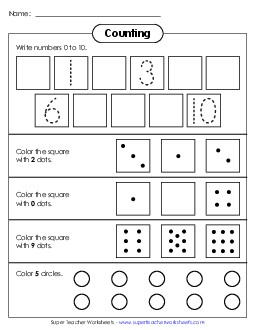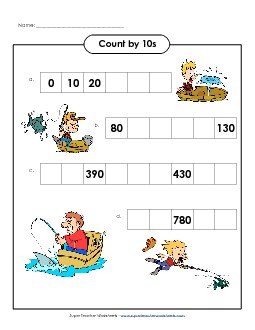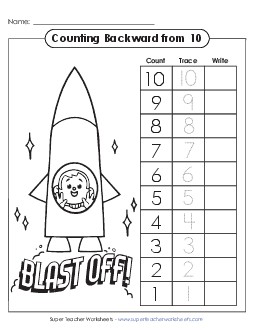Number Recognition and Counting Skills

Count objects and write numbers up to ten. Also includes ten frames, a memory match card game, number printing worksheets, and color-by-number mystery pictures.
Numbers Up to 20Use these worksheets to teach kids to read, write, and count numbers up to 20. Includes ten-frame worksheets, object counting activities, and a memory match game.
Numbers Up to 30Count and identify basic one and two-digit numbers up to 30. Includes worksheets, card games, dot-to-dot puzzles, and more.
Advanced Counting (2, 3, and 4-Digit Numbers)Count two, three, and four digit numbers with these worksheets. Includes before-and-after activities, counting up to 100 grids, and more.
Skip CountingPractice skip counting by 2s, 3s, 4s, 5s, 6s, 7s, 8s, 9s, 10s, 25s, and 100s.
Counting Backwards from 10 or 20Practice reverse counting from the number 10 or 20. Includes number writing worksheets as well as cut-and-glue activities.
Counting Backwards From2-Digit Numbers (From 99)
Practice counting backwards (reverse counting) from various 2-digit numbers.
2-Digit Place Value (Up to 99)These PDFs include place value blocks, and "I have/Who has" card game, place value mats, and activities for ordering numbers.
Hundreds ChartsOn this page, you'll find sets of 100 Charts and 120 Charts.
Counting MoneyCount quarters, nickels, dimes, and pennies.
Ten Frame WorksheetsUse ten frames and manipulative math objects to learn about counting, adding, and subtracting.
Dot-to-Dot PuzzlesConnect the dots to make fun pictures with these basic counting and skip counting printables.



Counting is one of the earliest and most fundamental math skills taught in elementary school, beginning as early as preschool and continuing through kindergarten and first grade. Learning to count helps children develop a sense of numbers and sets the stage for more advanced math concepts such as addition, subtraction, and place value. Early counting lessons focus on recognizing numbers, understanding their order, and counting objects one by one. Students also learn to count forwards and backwards, as well as skip count by 2s, 5s, and 10s. These basic skills are essential for building confidence and fluency with numbers.>/p>
In the classroom, teachers use engaging activities to make counting fun and interactive. For younger students in preschool and kindergarten, activities often involve physical objects like counting blocks, toys, or even everyday items such as fruit or buttons. Songs and rhymes, such as "Five Little Ducks" or "Ten in the Bed," help students memorize numbers and counting patterns. As students progress into first and second grade, they practice counting using number charts, number lines, and games that require them to count higher numbers or skip count. Counting exercises also appear in real-life scenarios, such as counting the number of days in the month or keeping track of classroom attendance, which helps students understand the practical applications of counting.
Super Teacher Worksheets knows that Understanding the core concepts of counting is vital for young learners because it forms the foundation for all other mathematical learning. Counting teaches students how to organize and compare numbers, recognize patterns, and develop problem-solving skills. Mastery of counting helps children move on to more complex mathematical operations like addition, subtraction, and eventually multiplication and division. A strong grasp of counting also improves number sense, allowing students to estimate, measure, and understand the relationships between numbers in real-world situations. By mastering counting early on, students build the skills and confidence needed for continued success in math throughout their education.






